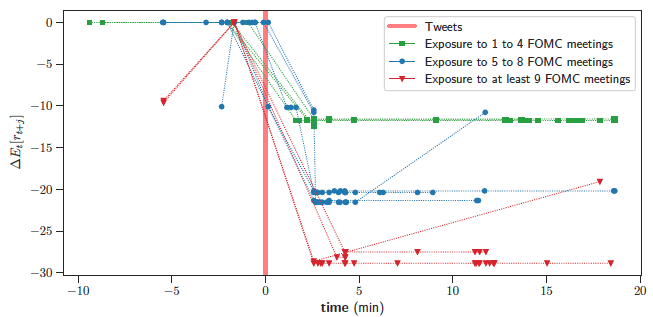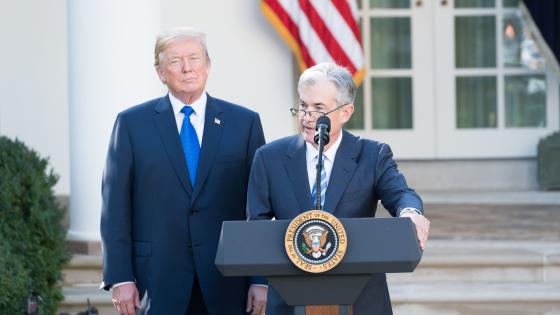In the aftermath of the Great Inflation a consensus emerged that for the effective conduct of monetary policy, central banks should be allowed to freely pursue objectives independently of political influence. In the 1960s and 1970s, however, the Johnson and Nixon administrations pressured the Federal Reserve chairman to keep interest rates low, eschewing price stability. This extended period of expansionary monetary policy contributed to the Great Inflation. To fight inflation, greater independence was established in the late 1970s by defining a dual mandate of price stability and maximum employment, followed by the creation of an arms-length relationship that insulated the Fed from interference by the executive branch. This enhanced autonomy allowed the Fed to aggressively target and stabilise inflation in the ensuing three decades.
The financial crisis in 2008 significantly weakened public confidence in central banks around the world (Kohn 2013). The unconventional policies implemented in the aftermath of the crisis further increased scrutiny of central banks, threatening the autonomy established in the previous decades. President Trump has been voracious in his frequent attacks on Fed policy. He launched his first attack on 18 April 2018, tweeting: “Russia and China are playing the Currency Devaluation game as the U.S. keeps raising interest rates. Not acceptable!”
Figure 1 illustrates the impact of the tweet on the expected fed funds rate implied by federal funds futures (FFF) prices in a 30-minute window. The futures contracts are stratified based on the number of Federal Open Market Committee (FOMC) announcements occurring before the corresponding expiration month. The change in expected rates is measured as percentage points of the average absolute change in expected rates following an FOMC announcement (around 2.2 basis points). The expected fed funds rate decreases noticeably across all three groups of contracts, with an increasing magnitude with respect to maturity.
Figure 1 The first tweet criticising the Fed
Notes: This plot shows the changes in expected federal funds rates at different horizons with respect to the first tweet that threatens central bank independence. The contracts are color-coded by their exposure to prior FOMC meetings before expiration. Contracts in the first group are exposed to between one and four FOMC meetings, contracts in the second group are exposed to between five and eight FOMC meetings, and contracts in the third group are exposed to at least nine FOMC meetings. Changes are reported as a percentage of the average absolute change in federal fund futures rates following FOMC meetings announcement since June 2015 (2.226 basis points).
In a new paper (Bianchi et al. 2020), we investigate market responses to threats to central bank independence with a high-frequency event study that exploits President Trump’s extensive use of Twitter as a tool for public communication. We scrape his account for tweets that relate exclusively to the Federal Reserve and unequivocally advocate looser monetary policy. We examine the impact of these tweets on expectations of the federal funds rate using tick-by-tick data on FFF contracts.
While movements in FFF rates have been used to identify monetary policy shocks following FOMC announcements (Gurkaynak et al. 2007, Nakamura and Steinsson 2018), we examine instead whether FFF rates react to news that in principle should not have any effect (i.e. President Trump’s tweets). The key insight is that if financial markets believe that the Federal Reserve is immune to political pressure, these tweets should not have any effect on market expectations about future monetary policy.
Markets do not see the Federal Reserve as immune from political pressure
We exploit a short time window around a single-second precision timestamp on the tweets. The payoff of FFF contracts depends on the average federal funds rate computed in the final month before expiry. As the fed funds target rate is set at eight predetermined FOMC meetings across the year, we classify futures contracts of different maturities based on the number of future meetings that precede the computation of the payoff. For each contract classification, we run a linear regression of the expected fed funds rate, implied by the futures price, on a dummy variable indicating five seconds before and five minutes after a tweet, including a time fixed effect to control for all other factors that influence expectations about future monetary policy.
Figure 2 reports the average effect of a tweet criticising the Fed. For the contracts whose payoffs occur strictly after one or more future meetings, the tweets have a negative and statistically significant impact on the expected fed funds target. The average effect across all contracts is around -0.25 basis points and the cumulative effect is -10 basis points, which is sizable considering that the typical change in the target rate at each FOMC meeting is ±25 bps. The effect grows with the time horizon, with a peak of -18.5 basis points at the longest horizon. Similar results emerge from a series of robustness checks that use different time windows, different criteria to select the tweets, and a joint estimation based on a linear system of pricing equations that collectively uses information from contracts of different maturities. We conclude that there is clear evidence that President Trump’s tweets lower market expectations and that the effect grows with the time horizon.
Figure 2 The effect of a tweet criticizing the Fed on the expected federal funds rate
Notes: The figure reports the average change in the expected federal funds rate across time horizons implied by contracts of varying maturities. The event study considers the expected federal funds rate, implied by the futures prices, and a dummy variable indicating whether the observation is before or after a President Trump’s tweet which criticizes the Federal Reserve. For each tweet and FOMC exposure, two trades of the same contract are chosen to measure the change in the expected federal funds rate. The selected contract for the exposure to j FOMC meetings has the shortest time to expiration and it is simultaneously exposed to at least j FOMC meetings before the month of expiration. The effect is measured in basis points.
Comparing the changes in expectations at different horizons provides valuable information for discerning whether the tweets affect the timing of an anticipated monetary policy change, or if instead they lead to a comprehensive revision in the expected course of monetary policy. We find evidence for the latter, suggesting that markets believe that President Trump is influencing the conduct of monetary policy in a persistent way, as opposed to simply inducing a change in the timing of monetary policy decisions.
A consistent message leads to sizable effects
In Table 1, we assess the relative importance of tweets criticising the Fed by reporting the mean and standard deviation of changes in the FFF rates in response to FOMC announcements, the critical tweets about the Federal Reserve, and tweets relating to trade and tariffs. Changes in the fed funds futures rate are computed as the average difference in the FFF rates across all horizons. For the trade and tariffs tweets, we also report the statistics for tweets conveying positive and negative news separately.
Table 1 Comparing magnitudes
Notes: This table reports the summary statistics for the changes in the Federal Funds Futures rates for all available maturities around FOMC announcements, tweets on the federal reserve, and tweets on trade and tariffs. The effect is measured in basis points. We provide the mean, standard deviation, and the number of observations in our data sample. To construct the statistics for FOMC announcements, we create an inner time window of 0.1 minutes prior to the announcement and 5 minutes after the announcement. The sample size reflects the number of events and the number of contracts for each event.
The average change in the FFF rate around the Fed-related tweets is approximately half of the average change around the FOMC announcements, highlighting the sizable effect of these tweets on market expectations. In contrast, the average changes around the trade and tariff-related tweets is quite small. The positive and negative trade and tariff-related tweets are associated with opposite movements in the fed funds rate, contributing to a noticeably smaller average change when both categories are pooled together. However, the average effect is still small when the tweets are separated into positive and negative news. We conclude that while these tweets can have large effects, their average effect is contained and smaller than the average effect of the Fed-related tweets. This is consistent with the heuristic observation that President Trump often uses Twitter to complain about trade partners without necessarily providing any new information about his attitude toward the issue of international trade. In contrast, the unified nature of the Fed-related tweets that concentrate on lower interest rates yields stronger effects on expected target rates.
Channel and motives
On 18 June 2019, Bloomberg published an article describing how President Trump had asked lawyers at the White House about the possibility of removing the Federal Reserve Chairman Jerome Powell. Figure 3 shows the response of expected interest rates to this news as a percentage of the average absolute change in FFF rates following an FOMC announcement. Interest rates decline across all maturities. At long horizons, the change is larger than the typical response to FOMC announcements. While historically a chairman has never been fired, Chairman Miller had a very short tenure and left the Fed to become secretary of the Treasury under Carter. The fact that markets reacted so strongly to the threat to remove Powell suggests that such an action is potentially a direct channel through which the president can influence monetary policy.
Figure 3 News threatening the removal of Fed Chairman Jerome Powell
Notes: This plot shows the changes in expected federal funds rates at different horizons with respect to the Bloomberg story that Trump allegedly asked White House lawyers for options on removing Powell. The contracts are color-coded by their exposure to prior FOMC meetings before expiration. Group A is exposed up to four FOMC meetings, Group B up to eight, and Group C to at least nine meetings. Changes are reported as a percentage of the average absolute change in federal fund futures rates following FOMC meetings announcement since June 2015 (2.226 basis points).
Finally, we explore how the attitude of President Trump towards monetary policy changed after he announced his campaign for the presidency. We select all tweets that comment on the Fed that predate 16 June 2015, the day on which Trump delivered his presidential announcement speech. Out of the 17 tweets we identify, three do not contain any criticism or praise of the Federal Reserve, while 14 criticise the Fed for being too dovish. These 14 tweets cover the period from 10 August 2011 to 7 August 2012, when economic conditions were arguably substantially weaker than in 2018-2019. The fact that Trump was advocating for more hawkish monetary policy before he decided to run for president, but has advocated for more dovish monetary policy since April 2018, suggests a shift in his attitude toward monetary policy motivated by his broader political agenda, akin to episodes of political interference in the past.
Conclusions
We find strong evidence that the consistent pressure applied by President Trump to pursue more expansionary monetary policy results in market expectations of a lower target rate. Our findings that market participants do not perceive the Federal Reserve to be fully independent from the executive branch has indirect, but important, consequences for the actual autonomy of the central bank. Evidence that the Fed closely monitors, and is affected by, market expectations of its own actions (e.g. Faust, 2016, Vissing-Jorgensen 2019) implies that even if President Trump does not directly influence Fed decisions, his political pressure can still affect policy indirectly by changing market expectations regarding the Fed.
References
Bianchi, F, T Kind, and H Kung (2020), “Threats to Central Bank Independence: High-Frequency Identification with Twitter”, CEPR discussion paper 14021.
Faust, J (2016), “Oh, What a Tangled Web we Weave: Monetary Policy Transparency in Divisive Times”, Hutchins Center working paper.
Gürkaynak, R S, B Sack, and E T Swanson (2005), “Do Actions Speak Louder Than Words? The Response of Asset Prices to Monetary Policy Actions and Statements”, International Journal of Central Banking 1(1): 55-93.
Kohn, D (2013), “Federal Reserve Independence in the Aftermath of the Financial Crisis: Should we be Worried?”, Business Economics 48(2): 104-107.
Nakamura, E, and J Steinsson (2018), “High-frequency Identification of Monetary Non-neutrality: The Information Effect”, The Quarterly Journal of Economics 133(3): 1283-1330.
Vissing-Jorgensen, A (2019), "Central Banking with Many Voices: The Communications Arms Race", UC Berkeley working paper.










